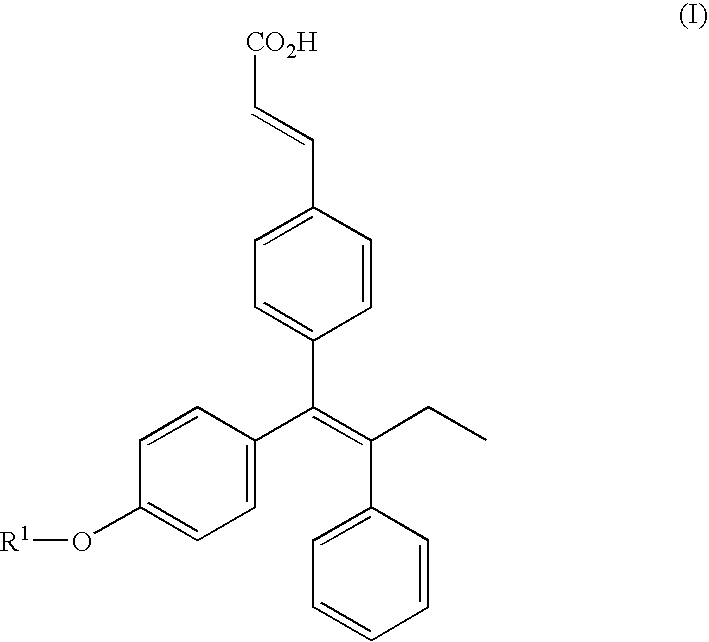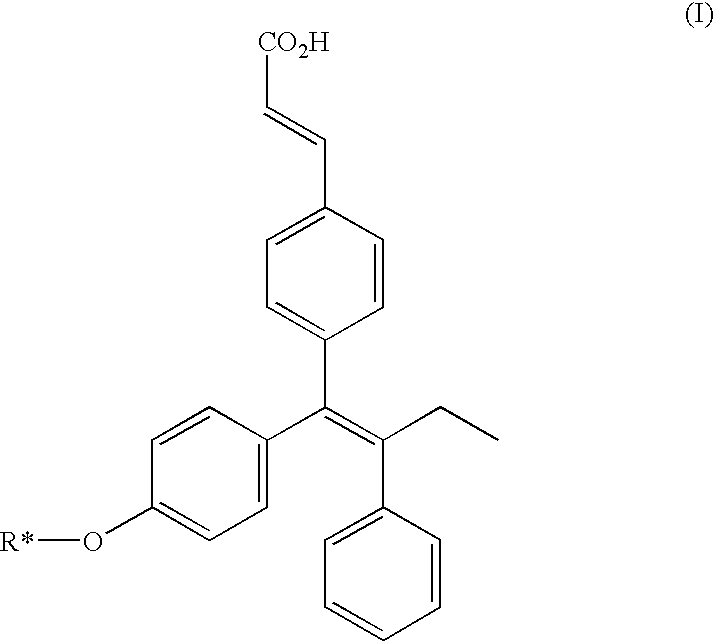Triphenylethylene compounds as selective estrogen receptor modulators
a technology of triphenylethylene and estrogen receptor, applied in the field of compounds and prodrugs, can solve the problems of increasing the risk of fracture, and increasing the economic burden of osteoporotic fractures
- Summary
- Abstract
- Description
- Claims
- Application Information
AI Technical Summary
Benefits of technology
Problems solved by technology
Method used
Image
Examples
example 1 (
1)
[0177]
Step 1: 1-(4-Methoxyphenyl)-2-phenylbutan-1-one (2)
[0178]2-Phenylbutyryl chloride (50.0 mL, 299 mmol) was dissolved in anisole (75 mL) and cooled to 0° C. AlCl3 (40.377 g, 303 mmol) was added portionwise and the resulting mixture allowed to warm to RT then stirred for 2 h. Ice was added portionwise followed by H2O (100 mL). The mixture was extracted with CH2Cl2 (3×100 mL) and the combined organics dried (MgSO4) and concentrated. The residue was distilled to remove the remaining anisole (1 mm Hg, 40-55° C.) to provide 2 (77.27 g, 100%) as a tan oil. 1H NMR (400 MHz, CDCl3): δ 0.90 (t, J=7.5 Hz, 3H), 1.85 (dq, 1H), 2.18 (dq, 1H), 3.81 (s, 3H), 4.40 (t, J=7.2 Hz, 1H), 6.85 (d, J=5.0 Hz, 2H), 7.19 (m, 1H), 7.28 (m, 4H), 7.95 (d, J=5.0 Hz, 2H).
Step 2: 1-[4-(diethoxymethyl)phenyl]-1-(4-methoxyphenyl)-2-phenylbutan-1-ol (3)
[0179]Magnesium turnings (9.64 g, 397 mmol) were heated to 160° C. under vacuum for 2 hours, then were cooled to RT under nitrogen. THF (400 mL) was added follow...
example 2 (
7, Preparation of Ester Prodrugs—Method A)
[0184]
Step 1: 1-(4-hydroxyphenyl)-2-phenylbutan-1-one (8)
[0185]A 5.0 L round bottom flask was charged with 164.2 (1.00 mol) (±)-2-phenylbutyric acid (III) and 110.3 g (1.02 mol) anisole and anhydrous toluene (575 mL) and stirred until dissolved. The resulting solution was cooled to 10° C. and 367.5 g (1.75 mol) TFAA added such that the temperature did not rise above 15° C. The solution was heated to 35° C. for 1 h then at 40° C. for 72 h. The solution was cooled to 20° C. and toluene (1300 mL) added followed by 2N NaOH (1.80 mol) with external cooling and vigorous stirring at a rate such that the reaction temperature did not rise above 35° C. The mixture was stirred for 1 h and the pH then adjusted to 10 by addition of 2N NaOH. The aqueous layer was removed and the upper organic layer was washed with H2O (900 mL). The aqueous layer was removed and the toluene layer concentrated to ˜1000 mL via atmospheric distillation. This solution was then...
example 3 (
7, Preparation of Ester Prodrugs—Method B)
[0190]
(2E)-3-(4-{(1Z)-2-phenyl-1-[4-(propionyloxy)phenyl]but-1-enyl}phenyl)prop-2-enoic acid (7)
[0191]To a stirred solution of the phenol 1 (1.0 g, 2.7 mmol) and Et3N (1.0 mL, 7.3 mmol) in THF (20 mL) at 5° C. was added, over 30 min, a solution of propionyl chloride (0.59 mL, 6.7 mmol) in THF (10 mL). After stirring at 5° C. for 1 h, H2O (30 mL) was added and stirring continued for an additional 1 h. The reaction was diluted with Et2O (60 mL), the layers separated, and the organics washed with H2O (2×40 mL) and concentrated to an oil. The oil was taken up in fresh THF (60 mL) followed by H2O (20 mL) and saturated NaHCO3 (20 mL) and stirred at ambient temperature for 8 h. The reaction was diluted with Et2O (20 mL) followed by H2O (30 mL) and the layers separated. The aqueous fraction was extracted with Et2O (2×30 mL) and the combined organics were washed with brine (50 mL), dried (MgSO4) and concentrated to a solid. This solid was stirred, as...
PUM
| Property | Measurement | Unit |
|---|---|---|
| weight | aaaaa | aaaaa |
| particle size | aaaaa | aaaaa |
| pH | aaaaa | aaaaa |
Abstract
Description
Claims
Application Information
 Login to View More
Login to View More - R&D
- Intellectual Property
- Life Sciences
- Materials
- Tech Scout
- Unparalleled Data Quality
- Higher Quality Content
- 60% Fewer Hallucinations
Browse by: Latest US Patents, China's latest patents, Technical Efficacy Thesaurus, Application Domain, Technology Topic, Popular Technical Reports.
© 2025 PatSnap. All rights reserved.Legal|Privacy policy|Modern Slavery Act Transparency Statement|Sitemap|About US| Contact US: help@patsnap.com



